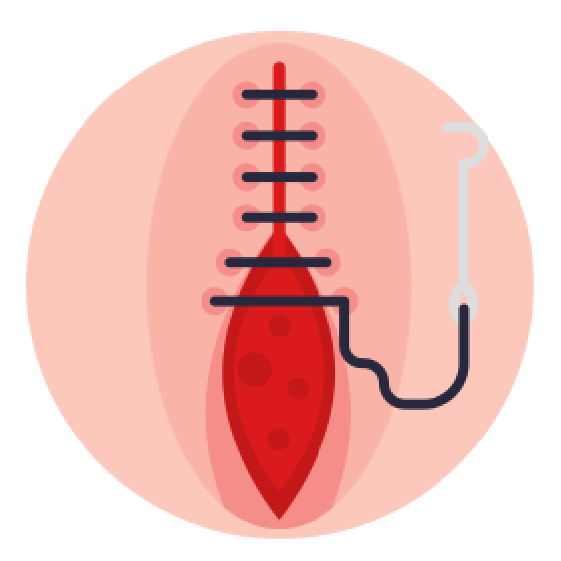Wound Care Clinic
Surgical Wound Care
A surgical wound, often referred to as a surgical incision, is a carefully planned and precise cut or opening created in the skin and underlying tissues by a healthcare professional during a surgical procedure. These wounds serve the purpose of providing access to the body’s internal structures or facilitating a specific surgical intervention. Surgical wounds are an integral component of a wide range of medical procedures, encompassing minor surgeries like the removal of small cysts and major surgeries such as open-heart procedures.
Surgical wounds are meticulously crafted in a sterile environment, where factors such as the presence of bacteria, wound size, location, and wound characteristics can be rigorously controlled.
These wounds are initiated by highly skilled healthcare practitioners for various purposes, including the treatment or further investigation of diseases or injuries. In every surgical procedure, a surgical wound or incision is essential for accessing the relevant layers of tissue required to address the underlying condition.
OUR ADVANTAGES
Let’s discuss on different types of Surgical Wounds
Surgical wounds can be categorized into one of four groups, with classification based on the degree of contamination, the risk of infection, and the wound’s location on the body.
Category I: These are classified as clean wounds, exhibiting no signs of infection or inflammation. They frequently involve areas such as the eye, skin, or vascular system.
Category II: These wounds fall into the clean-contaminated category. While there may be no immediate signs of infection, they carry an elevated risk of infection due to their location. For instance, surgical wounds within the gastrointestinal tract are prone to a higher risk of infection.
Category III: Surgical wounds that have come into contact with an external object, elevating the risk of infection, are considered contaminated wounds. For example, a gunshot wound can introduce contamination to the surrounding skin where the surgical repair takes place.
Category IV: Wounds in this category are categorized as dirty-contaminated. They encompass wounds exposed to materials like feces, presenting a significant risk of infection.
Watchful Signs and Symptoms
Keeping a close eye on surgical wounds is crucial to identify potential infections. Here are key indicators that a surgical wound may be infected:

Redness encircling the wound

Radiating Heat

Unpleasant Discharge

Venous Ulcers

Slow or non-healing wounds

Surgical wounds

Claim your free 20-minute doctor consultation online today!
Book Now ›

ABOUT US
Empowering Your Journey to Success
A surgical wound, also called an incision, is a deliberate skin cut created during a surgical procedure. Treatment for a surgical wound varies based on its location, typically involving regular dressing changes, cleaning the skin around it with soap and salt water, and irrigating the wound using a saltwater-filled syringe.
Chronic wounds can be characterized as wounds that do not progress through the typical stages of wound healing in a systematic and timely manner. Frequently, these wounds become stuck during the inflammation phase of the healing process. Chronic wounds can result from diabetes, vascular diseases, and infections. Chronic wounds are treated by healthcare professionals by removing dead, damaged, or infected tissues, using antibiotics dressings, and adding gel or ointments to keep the wound clean and moist.
Slow or Non-Healing Wounds: These types of wounds require an extended time to exhibit signs of improvement or do not heal completely. They can be caused by underlying medical conditions such as peripheral artery disease, malnutrition, or infection. Treatments would include biopsies, cryotherapy, nutritional support, and advanced dressings.
Pressure Wounds: These wounds are developed by prolonged pressure on the skin, occurring on the bony areas such as elbows, heels, and buttocks. Pressure wounds typically arise in individuals who spend most of their time sitting in one position, such as patients in wheelchairs. Therefore, it is essential to change position and move frequently to alleviate pressure on the ulcers and prevent the formation of new ones. Other treatments include specially designed mattresses, appropriate dressings, or adding gels and ointments on the wounds.
Call us
(281) 779-4045
Treatment
Options For Treating Surgical Wounds

- Closure Methods: Surgical wounds can be closed using various techniques, including sutures, staples, adhesive strips, or they may be intentionally left open to heal naturally. The choice depends on the wound’s location, type, and complexity.
- Drains: In certain cases, drains may be inserted into the wound and left in place for several days to remove excess fluid and promote healing. This is particularly common in complex or deep wounds.
- Dressing Application: After wound closure, a dressing is applied. Dressings come in various forms, from sterile gauze secured with tape to vacuum-assisted closure devices, depending on the wound’s needs.
- Antibiotics: To prevent infection, antibiotics are often administered both before and after surgery, especially for high-risk cases or when contamination is a concern.
- Supportive Care: In addition to wound-specific treatments, the focus is on overall health to enhance the healing process. This includes maintaining proper nutrition and hydration, monitoring the body’s internal chemistry through blood work, and ensuring adequate rest to aid recovery.
Professional Support
Expert psychological consultation services

Chronic Wound
A wound, whether acute (caused by an injury) or chronic (persistent), goes through a typical healing process involving stages of hemostasis, inflammation, proliferation, and remodeling.

Diabetic Ulcers
Diabetic ulcers, most commonly found on the feet, are open sores or wounds. They occur primarily due to poor circulation, neuropathy (nerve damage), and increased pressure on certain foot areas.

Venous Ulcers
Venous ulcers, a complication of venous insufficiency, have a notable impact on an individual’s quality of life. As these wounds can be notoriously hard to heal, understanding their origin and treatment is essential.

Pressure Wounds
Pressure wounds are injuries to the skin and underlying tissue caused by prolonged pressure on specific areas of the body. Understanding their cause, prevention, and management is crucial for maintaining skin health.
Acute & Chronic Wounds
Clinic For Wound Care
Acute & Chronic Wounds
Client Inquiries
Institution insights & answers to your questions
What are some potential issues that can arise with surgical wounds?
Infections stemming from surgical wounds typically manifest within a 30-day postoperative window. Infections may exhibit symptoms such as redness, pain, warmth, or the discharge of pus. To address infections, your healthcare provider might prescribe antibiotics or opt to reopen the wound for cleansing.
What does the recuperation process entail for surgical wounds?
The recovery period can vary considerably, spanning weeks to months. Your surgeon can furnish you with precise details regarding when you can expect to return to work, resume physical activities, and regain your normal daily routine.
What is the prognosis for surgical wounds?
A well-managed surgical wound generally has a favourable prognosis. Adhering to infection prevention guidelines enhances the likelihood of a successful healing outcome.
How can I care for my surgical wound at home?
Maintain the wound dry and clean, change dressings as instructed, take prescribed medications, and refrain from engaging in activities that might irritate the wound. These are just a few examples of the precise directions for wound care that your surgeon may provide.
Get appointment
Emergency that Requires Hospitaliszation: Call 911
Privacy Policy and Terms of Use Applied
